
A Step-by-Step Guide to Building Your App with a Food App Builder
The demand for convenient food ordering and delivery services continues to grow in today’s era. To build a successful food delivery app, you can leverage specific food app builders to simplify the development process. Now, we’ll go over the key processes and concerns for creating a food delivery app with a specialized app builder. We’ll go over the benefits of utilizing a food app builder, the features to include, the technological stack, and the whole development process.
Introduction
The food delivery sector has grown rapidly over the last decade and shows no signs of slowing down. With their hectic schedules and growing need for convenience, more individuals are turning to food delivery apps to satiate their hunger. If you want to get into this rich sector, a food app builder might be a useful tool in your app development journey.
What is a Food App Builder?
A food app builder is a software development platform that is particularly developed for the building of food delivery apps. These systems include pre-built templates, user-friendly interfaces, and a variety of functionality geared to the requirements of food delivery companies. Using a food app builder may help you save time, cut development expenses, and produce a more feature-rich app in a more effective manner.
In this blog, we’ll go over the stages needed in creating a food delivery app with a specific food app builder, as well as the important features, technological stack, and design considerations that are critical for your app’s success.
The Benefits of Using a Food App Builder
Before we go into the step-by-step process of creating your food delivery service, let’s talk about why you should use a food delivery app builder. Here are some benefits:
- Saves Time: A food app builder simplifies the development process by providing pre-built templates and components. This means you can drastically cut the time it takes to develop your software.
- Cost-Effective: Building a bespoke food delivery app from the ground up might be costly. A food app builder can help you save money by removing the need for a big development team and shortening the development time.
- User-Friendly: These platforms are user-friendly, making them accessible even to individuals with less technical understanding. You may concentrate on your company objectives while the builder handles the technical issues.
- Customization: While there are pre-built templates accessible, most food app builders allow for modification to meet your brand and specific needs. You may customize the look, features, and functioning of your app.
- Scalability: As your food delivery business expands, so should your app. Scalability features are available from many food app providers, guaranteeing that your app can manage rising user demand.
- Maintenance and Updates: Maintenance and updates are frequently provided by food app makers, ensuring that your app is always up to date and safe. This relieves you of the burden of continuing technical upkeep.
Steps to Create a Food Delivery App
1. Define Your Business Strategy
Before you begin developing your app, you must first identify your company plan. Take a look at the following:
– Target Audience: Who are your ideal clients? What are their preferences and habits regarding food delivery?
– Business Model: Are you going to collaborate with local eateries, open your own kitchen, or do both? Decide on your income plan (commissions, delivery fees, subscriptions, and so on).
– Competitive Analysis: Research your competitors and identify what sets your app apart from the rest.
– Monetization Strategy: Determine how you will monetize the app. This may include charging restaurants a fee to use your platform, collecting delivery costs, or charging consumers a membership price for premium features.
2. Choose a Food App Builder
Choosing the best food app builder is a critical decision. Some common choices are:
– Code Brew Labs: Code Brew Labs is a top-notch food app builder that offers a complete stack of technology and features for creating food delivery apps. It can integrate with any food applcations & businesses.
– Zomato Clone: This is a script-based solution that allows you to construct a food delivery app similar to Zomato. It’s a good alternative if you wish to duplicate the success of a well-known platform.
– GoodBarber: GoodBarber is well-known for its elegant and easily adaptable app themes. It may be used to build both restaurant and food delivery apps.
– Builder.ai: Builder.ai provides a more complex app creation environment with a high level of customisation. It’s an excellent choice if you have a clear concept for your project.
3. Design Your App
The design of every app is crucial to its success. Create a user-friendly and visually appealing interface using the templates and customization possibilities supplied by your selected food app builder. Think about the following design elements:
– User Interface (UI): Make sure the software is simple to use, with clear icons and controls. The color palette and layout should be consistent with your company’s branding.
– User Experience (UX): Pay attention to the app’s flow. Users should be able to easily explore restaurants, pick food, and place orders.
– Branding: In order to develop a strong brand presence, incorporate your logo and branding aspects throughout the app’s design.
4. Features and Functionality
To suit the demands of both users and restaurant partners, your food delivery app should include a diverse set of functions. Here are some important factors to consider:
– User Registration and Login: Allow people to establish accounts and login in using their email addresses, phone numbers, or social network accounts.
– Restaurant Listings: Display a menu and a list of eateries. For easier navigation, include search and filter options.
– Menu Customization: Allow consumers to personalize their orders, include specific instructions, and select from various payment options.
– Order Tracking: Allow users to follow the progress of their orders in real time so they may stay up to date on the status of their deliveries.
– Reviews and Ratings: Allow users to rate and evaluate restaurants and delivery services.
– Push Notifications: Notify customers with order changes, promotions, and discounts.
– Payment Integration: Integrate secure payment channels to make transactions easier.
– Delivery Management: Provide capabilities for handling orders and assigning delivery staff to restaurant partners.
– Admin Dashboard: Create an admin dashboard to manage users, restaurants, and orders, as well as to collect insights and data.
5. Backend Development
All of the magic happens in the backend of your food delivery app development software. It is in charge of data storage, user authentication, order processing, and communication between the app and third-party services. While food app builders make the process easier, it’s critical to understand the backend components and technology that allow your app to run smoothly. Backend technologies that are important include:
– Server: To host the backend of your app, you’ll need a dependable server. Popular cloud systems include AWS, Google Cloud, and Azure.
– Database: To store user and restaurant data, as well as order information, utilize a database system such as MySQL, PostgreSQL, or NoSQL databases such as MongoDB.
– APIs: Integrate APIs used by your app for money processing, location services, and third-party services.
– Security: Put in place strong security measures to protect user data and ensure secure transactions.
6. Testing
Thorough testing is crucial to ensure that your app works flawlessly. Here are the types of testing you should consider:
– Functional Testing: Test all of the app’s features to confirm they operate properly.
– User Acceptance Testing (UAT): Invite a group of people to test and offer comments on the app.
– Performance Testing: Examine how the program operates under different scenarios, such as large user loads.
– Security Testing: Identify and fix vulnerabilities to secure user data.
– Compatibility Testing: Make sure your app works on a variety of devices and operating systems.
– Usability Testing: Evaluate the app’s usability and make any required changes.
7. Launch Your App
When your app has been completely tested, it is time to make it available to the general public. This entails multiple steps:
– App Store Submission: Prepare your software for distribution through app shops such as the Apple software Store and Google Play. Follow their app submission rules, which include supplying app descriptions, images, and other essential files.
– Marketing: Promote your app through numerous methods, such as social media, influencer marketing, and paid promotion.
– Launch Event: To build hype and attract early consumers, consider having a launch event or promotion.
8. Post-Launch Activities
The job doesn’t stop once your app is launched. You will need to:
– Gather User Feedback: Collect consumer input on a regular basis and utilize it to make changes and updates.
– Analyze Data: Monitor app performance and user behavior to discover potential improvements.
– Marketing and Promotions: Continue to market your software in order to attract new users and maintain existing ones.
– Customer Support: Provide effective customer service to handle user questions and concerns.
– Scaling: As your user base expands, be sure your software can manage growing demand.
Conclusion
Building a food delivery app using a dedicated food app builder is a practical and effective approach to enter the increasing market of food delivery services. By following the methods mentioned in this article, you may develop a successful app that fits the demands of both customers and restaurant partners. Remember to outline your business plan, select the proper food app builder, design an appealing interface, add key features, manage backend development, perform extensive testing, efficiently launch your app, and continue to enhance and expand your app post-launch.
The food delivery sector offers several potential for entrepreneurs, and employing a food app builder might be a quick way to enter this competitive field.



